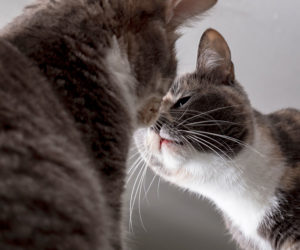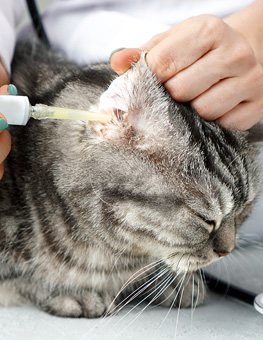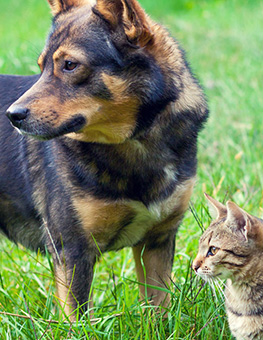How to Introduce Two Cats
Despite myths that cats are antisocial and like to be alone, most cats do enjoy the company of another member of their species. When left to their own devices outdoors, you’ll find that most cats live in social groups or colonies. However, just as it takes you time and several meetings to make a new friend, the acceptance of newcomers to the group will take time and practice. The majority of cats can get used to and benefit from living with a friend, although there are always exceptions and some match-ups just do not work.

You’ll want to plan ahead when thinking about adopting a new cat. Pick a cat who is compatible with your current cat. If you have a 13-year-old cat who likes to sleep all day, a kitten is probably not a good idea. Likewise, if you have a playful kitten at home, you will want to pick another young cat who can keep up with their energy.
Before Bringing Home Your New Cat…
Set up a “base camp” in your home prior to going to the shelter. This can be a spare room or a bathroom equipped with food and water, a litter box, toys, and a nice place to hide. Your new cat should stay here at minimum one week, but often it can take longer. Keeping your new kitty in this one room allows him to have time to decompress, take it slow, and get used to his new environment. Think about it – if you were uplifted from your former home and forced to live with a stranger, you’d want a space of your own, too.
You Should Avoid…
- Don’t throw the two cats together and let them “work it out.” This is stressful for both cats. A slow and gradual introduction where they can build positive experiences is best.
- Some people may feel tempted to put the new cat in a carrier or crate and let the old cat approach and smell him. This isn’t a good idea. It leaves your new cat feeling trapped and like they can’t escape, and can damage the relationship between your cats.
- Likewise, introductions with both cats on leashes are not recommended. Unless your cat is very used to wearing a harness and is walked regularly, putting a harness and leash on a cat is a stressful experience. You are pairing the stressful experience of wearing a harness and meeting a new cat together, ending in one very stressed out kitty!

The best way to have two cats see each other first time is through a baby gate where they each have the opportunity to move away if they choose. You should not hold or restrain the cats in any way during introductions.
Resources are important to cats – their food and water, their bed, their scratching post, even their litter box. When you have two cats, they each should be given their own set of resources, even if they are getting along. The less they have to share, the less competition there will be.
The Introduction Period…
This can take anywhere from one week to six months or even longer! Patience is key and remember that slow and steady wins the race. Rushing introductions can put cats into uncomfortable positions and they will start associating the other cat with stress. The following are a few helpful tips to follow when doing a slow and proper introduction:
Scent Swapping:
Scent is very important to cats. This new outsider doesn’t smell like them or your house, so he sticks out like a sore thumb to your cat. Rub on your cat’s cheeks and facial area using a sock or washcloth, then rub the same cloth all over the new cat, and then swap and do the opposite cat. The cheeks are full of the cat’s pheromones and scent glands and will deposit a stronger scent on the other cat. Once the cats begin to smell familiar to each other, they will start to accept each other more quickly.
Pair with Food:
Your main goal in the introduction period is to allow the cats to have short interactions that are completely positive so that they begin to pair the other cat with good things happening.
- Begin by feeding the cats on opposite sides of a closed door. If you don’t do scheduled mealtimes for your cats, you can simply feed high value treats like tuna or chicken. The cats will smell each other through the door and start to associate that extra yummy treat with the new cat. Gradually, you can crack the door so they have a limited visual of each other, then move to a baby gate with a blanket over it, raising the blanket a little at a time. It’s important to supervise them during this time in case they get stressed, you can close the door again or lower the blanket further.
- If one or both cats aren’t food motivated, then use playtime with a favorite toy, or just talk to them and give them lots of affection. These supervised “visits” through a door or gate should be a special, fun time for your cats.
Removing the Barriers:
After the kitties are comfortable taking treats and playing with toys on either side of a cracked door or baby gate, it’s time to remove the barrier and see if they are able to coexist on opposite sides of the same room. It’s easiest to have two people involved in this step: one per cat. The goal is to have both cats ignoring each other on opposite sides of the room while you give treats and play with each one separately. If you’ve been building up to this for a while with the barrier present, this should be easy!

Over time, you’ll gradually move the cats closer and closer to each other. If they decide they want to meet the other cat, this is okay. Remember that hisses and growls are just ways to communicate. A hiss means “back off! I need my space!” It helps the other cat know to create distance.
Remember to minimize negative reactions as much as possible. If things start to escalate beyond neutral or positive, calmly separate the cats and try again tomorrow. Keep sessions short at first (no longer than 5 minutes) to avoid issues. Always end sessions on a good note! After you have had several positive sessions, you can begin to gradually increase the amount of time they are out together until you feel comfortable leaving them without supervision.
Other Tips…
- Calming collars and treats and pheromone products can aid in the introduction process, but are not a fix-all. They should always be used in conjunction with the slow introduction.
- Pay close attention to your cat’s body language. Is their body tense or relaxed? Is their tail up or down? Are their ears forward or back? These subtle clues can key you in to how your cat is feeling about the interaction and may help you end a session before things escalate further.
-
You will know your cats are friends (or at least not enemies!) when they can co-exist in the same room with relaxed body posture. Remember to keep up positive interactions and reward good behavior even after the initial introduction period is over. If your cat walks up and sniffs the new cat, then casually walks away, praise him! That is a good thing.
- It can sometimes be difficult to distinguish between playing and fighting. Generally, cats who are playing will each participate equally and take turns. There should be no screaming during playtime – it’s generally quiet. Cats should keep their claws sheathed and not inflict any major wounds during play. If there is chasing involved, it should be reciprocal. If your cats do get into a fight during the introduction, do not reach in to separate them or attempt to pick them up. Use a squirt bottle or throw a blanket over them to herd them into separate rooms.














